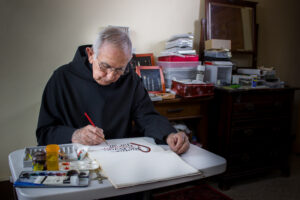Say What? Building A Monastic Vocabulary

Many monastic words and titles are uncommon. When the intentionarius begins describing the horarium (even my word processor is saying the word is spelled incorrectly), one unfamiliar with the terminology might feel the need for a translator. Here are a few words used in the monastery and their meanings:
- Bona Opera – The “good work” or Lenten practice chosen by a monk, including a book to be read, that is given to the abbot for his blessing before the beginning of Lent.
- Confrere – A fellow member of the monastic community, a brother.
- Chapter Room – Where the solemnly professed monks meet to discuss the business of the Abbey and vote on proposals for the Abbey.
- Customary – A book that details the customs, practices, and procedures of the monastery. One example at Mount Angel is tucking one’s napkin into the scapular during meals.
- Custos Domus – Literally “the keeper or custodian of the house,” the custos domus is the monk who trains other monks for household chores and helps ensure the monastery is clean.
- Grand silence – The complete silence observed in the monastery from the conclusion of Compline in the evening until breakfast.
- Hebdomidarian – A rotating weekly role, this monk leads prayers and reads the short readings at the Divine Office.
- Horarium – The daily schedule of prayer and work that monks live.
- Infirmarian – The monk who takes care of the brothers who are temporarily sick or chronically ill, including helping monks recovering from surgeries and ailments.
- Intentionarius – The monk who coordinates the Mass intentions, which are made for both the living and the deceased.
- Martyrology – The listing of the saints who were martyred on each day of the year. This is read at the conclusion of dinner and includes where they were killed, what year, and sometimes the circumstances of their death.
- Necrology – The lives of the monks of Mount Angel, read every other year at the conclusion of dinner. Necrology entries frequently mention the schooling, work assignments, hobbies, circumstances of death, and dispositions of the deceased brethren.
- Refectory – Where the monks eat in silence, listening to the reading of Scripture and an edifying book of the abbot’s choosing.
- Reliquarian – The monk who serves as custodian of the monastery’s relics, maintaining their documentation and presenting them to the faithful.
- Scullery – The area connected to the refectory where dishes and utensils are stored. This is where the weekly table servers prepare the food to be served to their brothers.
- Statio – The ordered lining up of monks in the monastery to process into the church, providing a valuable time of recollection for the monastic community. This is done daily for Vespers at Mount Angel and also for anticipated Vigils and Lauds on Sundays.
- Triforium – The area on the second floor of the Abbey church above the choir stalls. Infirm monks can continue to pray the Divine Office with their confreres from the triforium.
—Br. Alexander Delsman
Categories: Monastery
